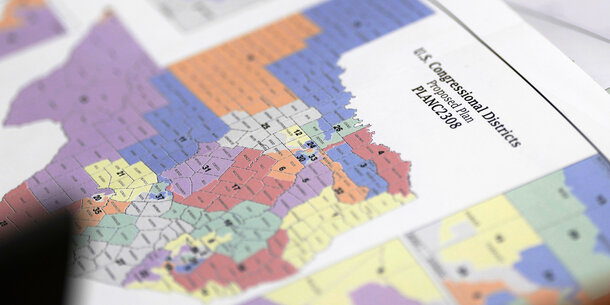The once-a-decade redrawing of legislative and congressional maps is still in its early phases, but a concerted Republican tactic for defending racially discriminatory maps is already clear. And thanks to a 2019 Supreme Court decision greenlighting partisan gerrymandering, they may just get away with it.
Racial discrimination is illegal. Partisan gerrymandering, the Supreme Court has said, is just the American way. You can guess what happened: Republicans are defending their racial gerrymanders by essentially saying, “Hey, it’s just party business.”
A decade ago, Republican map drawers aggressively redrew district boundaries to pack Black and other nonwhite voters into heavily minority districts, asserting that the Voting Rights Act made them do so. But that tactic backfired when courts struck down the wildly reconfigured districts as unconstitutional racial gerrymanders.
This time, Republicans are trying something different, claiming they are drawing maps on a “race blind” basis and leaning in hard on the argument that partisan politics motivated this decade’s maps, not race. How could our maps be racially discriminatory, they argue, if we had the race filters turned off in map-drawing software? The maps may badly dilute the power of communities of color, the argument goes, but that’s simply the by-product of our targeting of Democrats. As bluntly explained by one leading Georgia Republican defending this week’s dismantling of the seat of the only Asian-American woman in the state senate, “Yes, there was a political aspect, and that’s okay because that’s part of the process.”
Cue the eyerolls. Even without fancy mapping software, smart politicians know the demographics of their home regions like the backs of their hands. And in states like Texas and North Carolina with high rates of racially polarized voting, they know that Democrats are overwhelmingly people of color and that discriminating against Democrats is invariably racially discriminatory.
Consider this decade’s “race-blind” maps. In Texas, people of color were 95 percent of the state’s population growth last decade, but Republicans created no new electoral opportunities for communities of color and in many places went backwards. And in North Carolina, the state’s new maps could eliminate one of two Black members of Congress from the state as well as a third of Black state senators and a fifth of Black state house members.
Unfortunately, Republicans may get away with their ruse because of the Supreme Court’s opinion in Rucho v. Common Cause, which said that federal courts can’t hear partisan gerrymandering challenges brought under the U.S. Constitution. That decision creates a ready escape valve for map drawers in race discrimination cases by forcing courts to try to disentangle race and politics in maps, something that courts have long found hard to do. (Democrats also are guilty of using racial minorities for partisan advantage. In Illinois, a new lawsuit contends that maps passed this year by Democrats divides Black communities to strategically shore up vulnerable white Democratic incumbents.)
But the end of the story hasn’t been written yet. The Freedom to Vote Act, currently pending in Congress, could upset Republicans’ too-clever-by-half calculus by banning partisan gerrymandering in congressional redistricting and providing a strong judicial remedy for voters. By curtailing the ability of states to defend racially discriminatory maps on the basis of politics, Congress could strike a swift body blow both against partisan gerrymandering and efforts to subordinate the electoral voice of the country’s growing communities of color.
But time is running perilously short. Redistricting will be done in most of the country shortly after the first of the year. If Congress doesn’t pass the Freedom to Vote Act, this cycle of redistricting could be one of the worst in history for communities of color. Members will need to decide if they can live with that.



